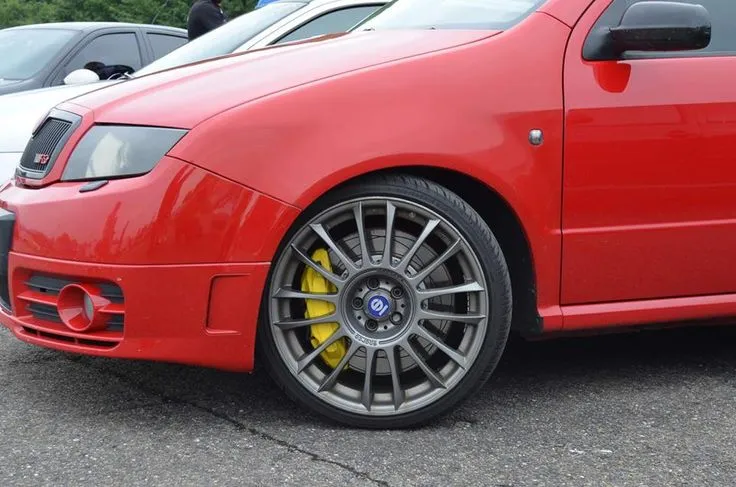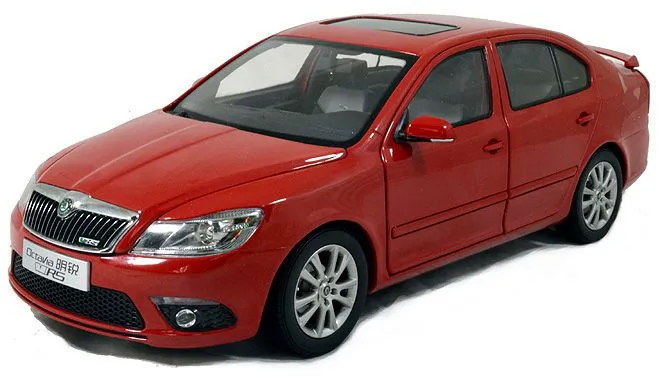Top 5 Diecast Skoda Octavia vRS Features
The Skoda Octavia vRS is a car that embodies sporty performance and practical design, and its diecast model counterparts perfectly capture this essence. These miniature replicas offer a unique way for enthusiasts and collectors to appreciate the Octavia vRS. Diecast models offer a level of detail and craftsmanship that makes them highly sought after. Here are the top five features that make these diecast models stand out, making them a must-have for any car aficionado. The features showcase how these models bring the real-world car’s charm into a small, collectible package. The attention to detail and the materials used contribute to the overall quality and appeal of these miniature vehicles.
Detailed Exterior Features
The exterior of a diecast Skoda Octavia vRS is where the model makers truly showcase their skill. The models meticulously replicate every curve, line, and detail of the original car. You’ll find accurately reproduced front grilles, headlights, and taillights, often with clear lenses and realistic detailing. The paintwork is usually of high quality, with a glossy finish that mirrors the real car’s sheen. The addition of realistic badging, such as the Skoda logo and vRS emblems, adds to the authenticity. Door handles, mirrors, and even the fuel cap are carefully crafted, ensuring that every aspect of the exterior is as close to the original as possible. The goal is to provide a scaled-down version that looks and feels like the real thing, appealing to both casual admirers and serious collectors alike.
Paint and Finish Quality

The paint and finish are critical elements that significantly impact the overall appearance of the diecast model. High-quality models use premium paints that provide a smooth, even, and vibrant finish. The paint is applied with precision, ensuring that every surface is covered without any imperfections. This meticulous attention to detail is vital to capture the original car’s aesthetic appeal. A glossy finish often replicates the shine of a newly waxed car, enhancing the model’s realism. Moreover, the durability of the paint is another consideration; high-quality models can withstand handling and exposure to light without significant fading or damage. The paint job’s quality can make or break the model’s overall appeal and value, with collectors often prioritizing models with flawless paintwork.
Wheels and Tires
Wheels and tires are another critical feature in accurately representing the Skoda Octavia vRS. Diecast model manufacturers pay close attention to the design and detailing of the wheels, replicating the specific alloy wheel designs found on the real car. The tires often feature realistic tread patterns and sidewall markings, enhancing the model’s authenticity. The wheels are often made of metal or high-quality plastic and are precisely mounted to the chassis, allowing them to roll smoothly. The tires’ material and design also contribute to the model’s overall look and feel. From the sporty appearance of the wheels to the grip-like design of the tires, these details add to the model’s realism. This precision is one of the many details collectors and enthusiasts appreciate, as it helps the model reflect the car’s actual characteristics.
Interior Detailing
The interior of a diecast Skoda Octavia vRS is as detailed as the exterior. Model makers often reproduce the dashboard, seats, steering wheel, and other interior components with incredible accuracy. Dashboard detailing includes instrument panels, infotainment screens, and air vents, with the addition of realistic textures and colors to match the original car’s interior. Seats are often designed with specific patterns and stitching, reflecting the quality of the real vRS seats. The steering wheel will have accurate shapes and even the correct logo. This detailed interior brings a miniature replica to life. The small details, like gear sticks and door panels, enhance the overall realistic look, making the model attractive for display and collection purposes.
Dashboard and Seats

The dashboard and seats are primary focal points within the interior, showcasing the model’s craftsmanship. The dashboard is detailed with realistic gauges, infotainment screens, and air vents. The materials used often replicate the textures found in the real car, such as soft-touch plastics and carbon fiber accents. Seats are intricately designed, often mimicking the sports seats in the vRS. This includes accurate stitching patterns, color schemes, and even the headrest shapes. The level of detail in the seats and dashboard enhances the model’s overall quality and collector’s appeal. This focus on detail enhances the model’s realistic quality. These elements provide a more immersive experience for collectors, contributing significantly to the value and desirability of the model.
Engine and Chassis Details
Many high-quality diecast models provide a glimpse of the engine and chassis. While not always fully visible, elements like the engine block, exhaust system, and suspension components are often represented. These details enhance the overall realism of the model. The chassis is usually detailed with components like the exhaust system, suspension, and undercarriage elements, further boosting the model’s authenticity. This level of detail makes the model more appealing to automotive enthusiasts and serious collectors who value accuracy and realism. The engine details will show the type of engine present in the real car, enhancing the experience for car lovers.
Scale and Accuracy
Scale and accuracy are essential aspects of a diecast model, playing a critical role in its appeal and value. The most popular scales for diecast models are 1 18 and 1 43, among others. These scales help collectors and enthusiasts appreciate the level of detail and the overall look of the model. Models are created to precise ratios of the original vehicle. Accurate dimensions, proportions, and features create a realistic miniature representation. The accuracy in scale ensures that every detail, from the exterior to the interior, is proportionate and correct. The precision in scale and accuracy is what allows these models to stand out as collectible items. This attention to detail is what makes these models so highly valued by collectors.
The Importance of Scale

Scale is fundamental in determining how the model relates to the real car. The most common scales are 1 18 and 1 43, but other scales exist. Each scale provides a different level of detail and size. 1 18 scale models offer a greater level of detail, allowing for more intricate features, while 1 43 scale models are often more compact and easier to display. The scale chosen by the model manufacturer influences the overall appearance, dimensions, and complexity of the details. The chosen scale affects the overall quality and display. Collectors often specialize in a specific scale. The scale affects how the model displays and how it relates to other models in a collection, influencing its appeal and value.
Overall Accuracy
Overall accuracy encompasses every detail of the model, from its exterior dimensions to interior features. Accurate dimensions, proportions, and features create a realistic miniature representation of the Skoda Octavia vRS. High-quality models replicate every aspect of the original car. This includes the design of the body, the details of the interior, and the functioning of the doors and hood. Manufacturers use original design specifications and images of the real car. The precision in the details helps the models to reflect the real car’s characteristics. Accuracy isn’t just about the appearance; it also covers the model’s build quality, the materials used, and the assembly. Accurate models are highly desirable to collectors, because of their similarity to the real car.
Materials and Construction
The materials used in the construction of a diecast Skoda Octavia vRS model significantly impact its durability, weight, and overall feel. The body is typically made of diecast metal. This material provides a realistic weight and a solid feel. Other components include high-quality plastics for the interior and clear parts for windows. The construction process involves assembling various parts with precision. This attention to detail contributes to the model’s value and appeal. The materials determine the model’s durability, aesthetic appeal, and longevity. Diecast metal provides a smooth finish, and plastic components offer detail and functionality. Careful attention to material choices and construction techniques is crucial for creating a quality model.
Diecast vs Plastic

The primary construction materials in a diecast model are diecast metal and plastic. Diecast metal, typically an alloy of zinc, is used for the body and chassis, lending a sense of realism and weight. The use of diecast metal provides durability and a premium feel. Plastic parts are used for the interior components, windows, and other detailed features. High-quality plastics provide intricate detailing. The choice between diecast metal and plastic influences the model’s appearance, weight, and value. Diecast metal parts will last longer, and plastic parts offer a high level of detail. Both materials have specific advantages and drawbacks. The model’s overall quality hinges on the selection and proper application of each material. Collectors appreciate the materials, and they influence the model’s value.
Metal Body and Components
The use of a metal body and components in diecast models is a hallmark of quality. The metal body provides the model with a robust structure and a realistic weight. The components include doors, hoods, and trunks. The diecast metal provides a base for the paint, finish, and detailing. The metal components are durable and long-lasting, increasing the model’s value. Collectors often prefer diecast metal models. It gives the impression of a premium quality and enhances the overall experience. This choice of materials helps to produce a realistic model.
Collectibility and Value
Diecast Skoda Octavia vRS models are popular collectibles, often increasing in value over time. Their collectibility is influenced by factors such as rarity, limited editions, and the model’s condition. Collectors often seek out models with specific paint schemes or those from limited production runs, which can increase their value significantly. The model’s condition is critical. A model in pristine condition will always be more valuable than one that has damage. Diecast models are more than just toys. They represent a passion for cars and a desire to own miniature versions of beloved vehicles. Understanding these factors helps both collectors and enthusiasts. The collectibility and value of these models depend on factors such as rarity and edition size.
Factors Affecting Value

Several factors influence the value of a diecast Skoda Octavia vRS model. Rarity, limited editions, and the model’s condition are crucial. Models from limited production runs are usually more valuable. The model’s condition is paramount. Models in mint condition, with their original packaging, are much more valuable. Historical significance also plays a part. If a model represents a specific year or a car that is important, the value increases. The original packaging can affect the model’s price. The original box and documentation add to the authenticity. These factors combine to influence the value, making some models more sought-after than others. Collectors carefully assess these factors when acquiring and valuing models.
Rarity and Limited Editions
Rarity and limited editions significantly impact the value of diecast Skoda Octavia vRS models. Models produced in limited quantities are highly sought after by collectors. Limited edition models often have unique paint schemes, details, or packaging. These models are much more valuable. The rarity increases the appeal. The number of models produced affects the desirability. The exclusive nature is important for the value. The rarity can arise from the specific features of the model. Collectors often seek out these limited editions to diversify their collections. The uniqueness and exclusivity of these editions make them highly valuable assets.
